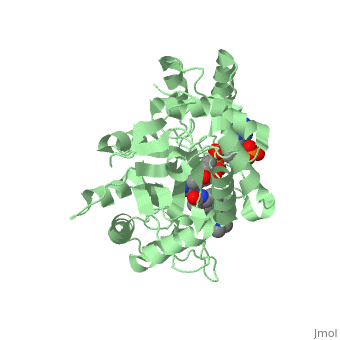User:Cody J Cubbage
N-(1,1-dimethylethyl)-3-oxo-(5α,17β)-4-azaandrost-1-ene-17-carboxamideN-(1,1-dimethylethyl)-3-oxo-(5α,17β)-4-azaandrost-1-ene-17-carboxamide
FunctionFinasteride is a synthetic 4-azasteroid compound that acts as a 5α-reductase inhibitor. The 5α-reductase enzyme is very important in the metabolism of many of the steroids produced by the body, in particular the conversion of testosterone to dihydrotestosterone (DHT). For this reason, Finasteride is used as a treatment for benign prostate hyperplasia (BPH), which is caused by an overproduction of DHT in the male prostate. Pattern hair loss, another condition in men, caused by the build up of DHT, can also be treated with Finasteride. StructureFinasteride belongs to the subclass of steroids called azasteroids. All steroids contain a core structure called gonane, a structure composed of 3 cyclohexane rings and 1 cyclopentane ring "fused" together. Although gonane has 6 chirality centers, giving it 64 possible steroisomers, the majority of steroids contain the 5α-gonane stereoisomer. The function and naming of steroids are determined by what functional groups are attached to the rings of gonane and by the substitution of carbon atoms in the rings with different atoms. In the case of Finasteride, two methyl groups have been attached to carbons 10 and 13 of the gonane structure, placing it in the androstane classification of steroids. The gonane ring is further modified by the addition of a double bond at carbon 1 and a ketone to carbon 3. Carbon 4 in Finasteride has been substituted with a nitrogen atom, making Finasteride a 4-azasteroid. Finally, a carboxamide has been added onto the carbon 17. The nitrogen present in the carboxamide has been with a tert-butyl group. MechanismFinasteride is a 5-alpha reductase inhibitor. There are two isoforms of the 5alpha-reductase enzyme, type I and II, and while the drug has a higher affinity for the type II enzyme, it also inhibits the function of the type I. (.....) Typically 5 alpha-redcutase turns testosterone into Dihydrotestosterone(DHT), but the enzyme will accept Finasteride as an alternate substrate; turning it into dihydrofinasteride through an enzyme bound, NADP-dihydrofinasteride adduct. Finasteride is similar in structure to testosterone and 5alpha-reductase has almost the same affinity for both molecules. However, Finasteride , having a high affinity for 5 alpha-reductase, covalently binds to the enzyme as a Michael acceptor, through a functionally irreversible reaction. However, the NADP-dihydrofinasteride complex breaks down with a half life of about 1 month at 37˚C., which is why patients must continue taking the drug.(.....) Medical UsesFinasteride is used to shrink an enlarged prostate, also known as benign prostatic hyperplasia (BPH), in adult men. This medication works by inhibiting 5a-reductase, which prevents conversion of testosterone to the natural body hormone, dihydrosestosterone (DHT) that causes growth of the prostate. Finasteride is specific for type II isoenzymes, resulting in a decline in serum DHT levels by 65-70% and in prostate DHT levels by up to 80-90% (source).
|
| ||||||||||
ReferencesReferences
</references>
